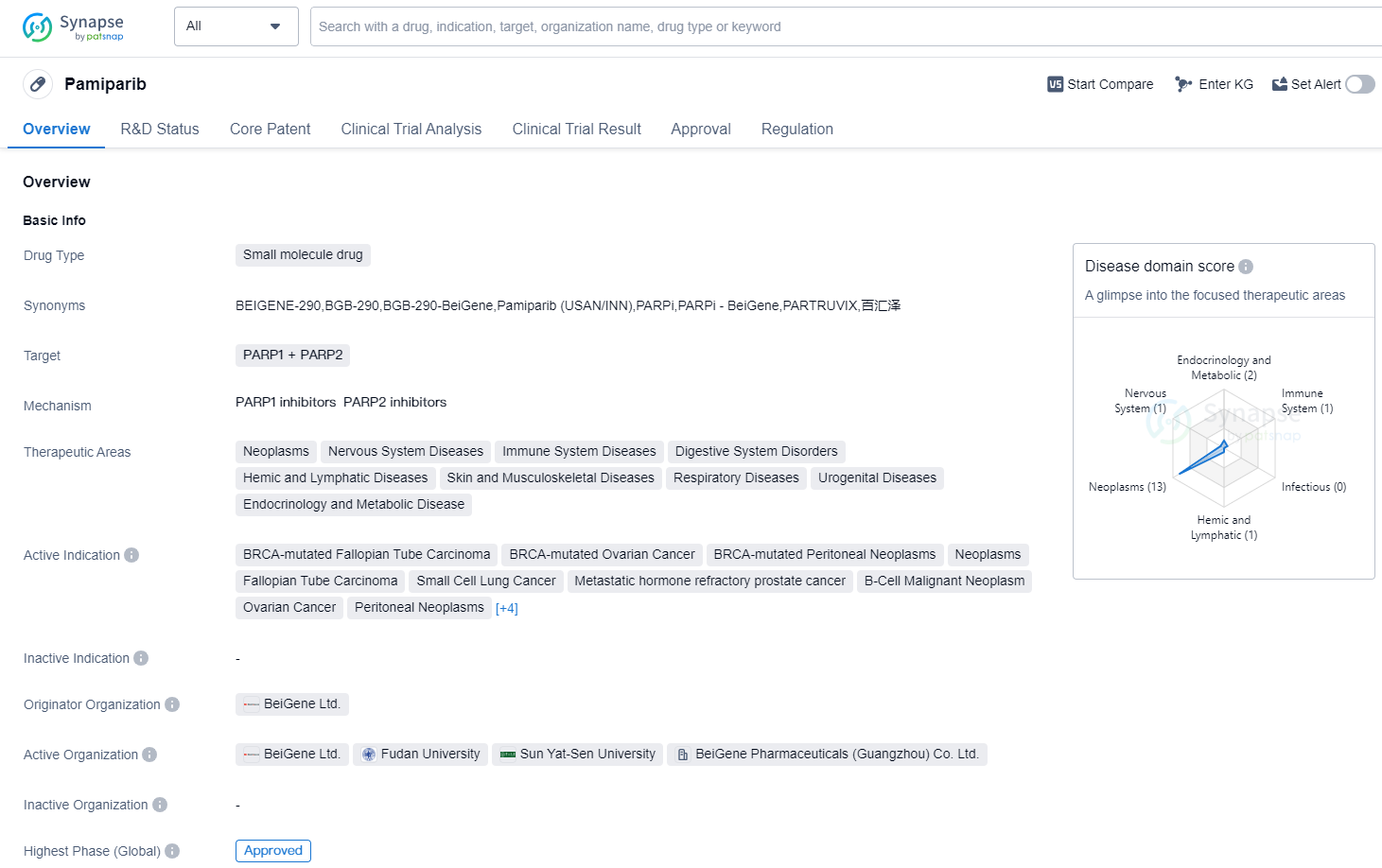Unleashing the Power of pamiparib: A Comprehensive Review on R&D Breakthroughs
Pamiparib's R&D Progress
Pamiparib is a small molecule drug that targets PARP1 and PARP2. It has been approved for use in various therapeutic areas including neoplasms, nervous system diseases, immune system diseases, digestive system disorders, hemic and lymphatic diseases, skin and musculoskeletal diseases, respiratory diseases, urogenital diseases, and endocrinology and metabolic diseases.
The drug has shown efficacy in treating several active indications, including BRCA-mutated Fallopian Tube Carcinoma, BRCA-mutated Ovarian Cancer, BRCA-mutated Peritoneal Neoplasms, Neoplasms, Fallopian Tube Carcinoma, Small Cell Lung Cancer, Metastatic hormone refractory prostate cancer, B-Cell Malignant Neoplasm, Ovarian Cancer, Peritoneal Neoplasms, Stomach Cancer, Triple Negative Breast Cancer, Glioblastoma, and Solid Tumors.
Pamiparib was developed by BeiGene Ltd., an originator organization in the pharmaceutical industry. The highest R&D phase of this drug is approved. The drug obtained its first approval in China in April 2021.
In terms of regulation, Pamiparib has undergone priority review, conditional marketing approval, and is part of a special review project. These regulatory designations indicate that the drug has demonstrated promising results and may offer significant benefits to patients in need.
👇Please click on the image below to directly access the latest data (R&D Status | Core Patent | Clinical Trial | Approval status in Global countries) of this drug.
Mechanism of Action for pamiparib: PARP1 inhibitors PARP2 inhibitors
PARP1 inhibitors and PARP2 inhibitors are types of drugs that target the enzymes poly (ADP-ribose) polymerase 1 (PARP1) and poly (ADP-ribose) polymerase 2 (PARP2), respectively.
From a biomedical perspective, PARP1 and PARP2 are enzymes involved in DNA repair processes. When DNA damage occurs, PARP1 and PARP2 play a crucial role in repairing the damaged DNA strands. However, in certain conditions such as cancer, inhibiting PARP1 and PARP2 can be beneficial.
PARP inhibitors work by blocking the activity of PARP enzymes, preventing them from repairing DNA damage. This is particularly effective in cancer cells that already have impaired DNA repair mechanisms. By inhibiting PARP1 or PARP2, these drugs can lead to the accumulation of DNA damage in cancer cells, eventually leading to their death.
PARP inhibitors have been primarily used in the treatment of certain types of cancers, such as ovarian and breast cancer, that have specific genetic mutations, such as BRCA1 or BRCA2 mutations. These mutations impair the DNA repair mechanisms, making cancer cells more reliant on PARP-mediated DNA repair. By inhibiting PARP1 or PARP2, the DNA repair process is disrupted, leading to the selective killing of cancer cells while sparing normal cells.
It's worth noting that PARP1 and PARP2 inhibitors can have different specificities and potencies towards their target enzymes. Some inhibitors may selectively target PARP1, while others may have a broader spectrum of activity against both PARP1 and PARP2. The development of PARP inhibitors has shown promise in improving cancer treatment outcomes, particularly in patients with specific genetic mutations.
Drug Target R&D Trends for pamiparib
PARP1 and PARP2 are enzymes that play a crucial role in DNA repair and maintenance in the human body. They are involved in a process called base excision repair, which helps fix damaged DNA by removing and replacing damaged or mismatched bases. PARP1 and PARP2 also have a role in regulating gene expression and cell death. Additionally, they are involved in various cellular processes, including DNA replication, chromatin remodeling, and telomere maintenance. Dysfunction of PARP1 and PARP2 has been linked to various diseases, including cancer and neurodegenerative disorders. Targeting these enzymes with PARP inhibitors has emerged as a promising therapeutic strategy in the pharmaceutical industry.
According to Patsnap Synapse, as of 14 Sep 2023, there are a total of 24 PARP1 + PARP2 drugs worldwide, from 70 organizations, covering 99 indications, and conducting 1172 clinical trials.
Overall, the analysis of the current competitive landscape and future development of target PARP1 + PARP2 indicates a strong presence of companies, significant progress in drug development for various indications, a focus on small molecule drugs, and advancements in multiple countries/locations, including China. The target PARP1 + PARP2 holds promise for the treatment of various types of cancer, and further research and development efforts are expected to drive future advancements in this field.
👇Please click on the picture link below for free registration or log in directly if you have a freemium account, you can browse the latest research progress on drugs, indications, organizations, clinical trials, clinical results, and drug patents related to this target
Conclusion
Overall, Pamiparib is a small molecule drug that targets PARP1 and PARP2 and has been approved for use in various therapeutic areas. Its efficacy has been demonstrated in multiple active indications, and it has received approval in global markets. The drug was developed by BeiGene Ltd. and has undergone rigorous regulatory review, including priority review and conditional marketing approval. Its approval in China in April 2021 marks an important milestone in the treatment of the indicated diseases.






